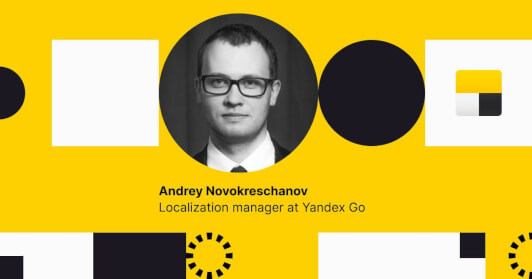We spoke with Andrey Novokreschanov, the localization manager of rideshare, logistics, and food delivery services in Yandex.Taxi (the apps of Yandex Go and Yango). We spoke about the localization process at Yandex and what role is dedicated to Smartcat.
— Andrey, can you tell us about your experience working as a localization manager at Yandex Go?
— I joined the team three years ago. I help with a whole variety of tasks — from mobile app UI localization and up to the translation of documents and communications (push- and fullscreen- messages, various in-app content). All in all, I am responsible for how the service "speaks" in languages other than Russian.
— How long have you been in the translation business?
— I've worked for 15 years in this industry so far, both as a translator and a project manager. A few years ago, I've decided to narrow down my specialization and do localization project management. There's plenty of opportunity for growth! Every new country and new service jolt you with fresh emotions and challenge your abilities.
— What services are available at Yandex Go?
— Yandex Go is a super app based on Yandex.Taxi. Travel has always been its main focus. Nonetheless, our service has been more than just a rideshare service from point A to point B for a while now. In August 2020, our app has been transformed into Yandex Go, and now, apart from taxi services, the app includes car-sharing, logistics technology (including cargo shipping), and public transport route tracking. Two food-tech delivery services also made into our super app: Yandex.Lavka and Yandex.Eda.
Within Russia and the CIS countries, the service is available under the name Yandex Go. The second brand of the service is called Yango and operates in Africa, Israel, and Finland. In these countries, in general, we promote ridesharing and delivery services, although other new services originating from Russia also make their way there. For instance, at the end of 2020, in Israel, a new service - Deli by Yango, the international brand of Yandex.Lavka, has appeared. It's a good example of what the localization department is after — it's not about mere translation from Russian and English to Hebrew, it's about a completely different brand, language, tone, visuals, and marketing.
The company also handles the Uber brand in Russia and some other neighboring countries, namely, Kazakhstan, Belarus, and Azerbaijan. There, Uber KZ, Uber BY, and Uber AZ operate, respectively.
— In what languages are Yandex Go services available?
— Yandex Go and Yango operate in 17 countries as of today. Russia is the main home market. The international direction we've begun with the CIS countries, later adding up the Baltics, Serbia, other Euro-zone countries, Africa, and Israel. There are plans to introduce the services to other regions. For instance, before the middle of Summer, Yango Deli will appear in Paris, and by Fall — in London.
At the moment, we've got 16 languages in our arsenal. Naturally, English is the main one — without it, the service cannot exist. Apart from English, among the popular languages in the app, we have Armenian, Finnish, Serbian, and Hebrew since we've got quite a number of users in these countries and the majority of them don't speak Russian. Kazakhstan is another large market, but 97% of its users use the Russian version of the app.
We place importance on every language. We localize a new feature to all 16 languages, even if it makes an appearance in Russia only. After all, the language is used not only in the country that holds it as the main one. For instance, Armenians, Azerbaijani, Kirgiz, Uzbek, and other nationals living in Russia often choose their own language in the app. You probably do that as well when you go to a foreign country — you probably don't change the settings on your smartphone and continue to use the services in the same language.
— What localization process problems do you deem the most important at the moment? How does your team approach these problems?
— I think the problems are always the same — deadlines, money, and translation quality. The three whales.
Yandex Go tried to find an answer to this by creating a localization department within the company. In the "big" Yandex, there is a separate localization and documentation department that supports all the services of the company. However, the international direction of ride-hailing and food tech services has grown very quickly and actively, and at some point, the HQ couldn't keep up with our growth. Thus we've got our own department. That helped to drive down the costs, increase the translation speed, and improve the localization quality.
— How come Smartcat happened to be more attractive among the competition, what made it stand out?
— We were looking for a CAT tool that would meet two requirements — it would be inexpensive (ideally, it would be free to use) and it wouldn't consume too much time to learn.
We've looked into using SDL Trados, CrowdIn, and Smartcat. We chose the latter due to convenience: the translators could easily register in the system, and those who worked with CAT tools before easily started their work in Smartcat. One more killer feature in Smartcat is, without a doubt, its convenient interface for translator payments.
— How long have you been using Smartcat?
— More than two years.
— How did you integrate it into your existing processes? How much time did the integration take?
— That task was simultaneously easy and hard. The process took a couple of months to complete. Considering a large number of existing systems that we had to integrate on "big" Yandex's end, as well as the fact that we had to establish the processes from scratch on Yandex Go's side, the integration was notably swift.
We did an MVP integration of Smartcat and our internal systems and continue to improve it further. We want to set up a single incoming flow of requests and make it simple and straightforward. We have a number of teams: product managers, editors, marketers, lawyers, and translators — each team is using its own tool. The goal of the MVP integration was in the creation of a single point of communication for these otherwise standalone teams.
Speaking plainly, this is a system for documentation storage (including cloud), task tracker, and САТ tool (that is, Smartcat). And under the hood — a lot of connector scripts and back-end systems that ensure non-stop work.
— What changed after implementing Smartcat?
— Thanks to the fact that in Smartcat it's possible to interact with suppliers, the processes are more clear and the quality and speed of localization have grown. That's exactly the result we were after. We run dozens of projects simultaneously and work with a huge number of teams, so the translation speed is critical to us.
Smartcat managed to do something that Uber accomplished on the ridesharing market once: remove a number of links from the service delivery chain. Before, to get a cab, you had to do a lot of things. Now, thanks to Uber, you can do that in one click. The service quality has not decreased, too. Smartcat managed to do that in the translation industry.
It's important to note that in Smartcat, just like in Uber, there is an instant feedback channel with the clients. If fifteen years ago you didn't like a taxi ride, few could ever learn about that. Now, the supplier gets comments from the client immediately — the driver from the passenger, the translator from their client, or the editor.
— What metrics have grown?
— We track the number of bugs in the localization — the users report them to the Support service. As soon as we started to use Smartcat, the number of complaints has decreased, meaning there were fewer mistakes.
Another metric — the speed of service delivery, or the SLA that we must comply with. The localization department at Yandex Go is involved in the release of new app features, so we can't afford to move the deadlines and deliver translations later. There is no single SLA for the entire team, but the deadlines depend on the request. Now, we manage to meet the SLA deadlines 100% of the time for some tasks, while for some others, the delivery time has decreased altogether.
— What can you recommend to businesses that face localization issues?
— It's hard to give advice, everyone walks their own path. Personally, I recommend to try different approaches. Work with freelancers, agencies, outsourced teams. Combine them together, try hybrid models.
I would also recommend trying the freelancer search option. If you work with an agency, offer them this option. Think outside the box and keep a good pace — these days, everything is dynamic and changes constantly. Thanks to platforms like Smartcat, the opportunities are all around you: you can compare your on-premise CAT system with a cloud one, including trying out the solution in free test mode.
Subscribe to our newsletter


